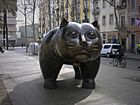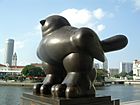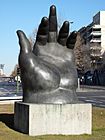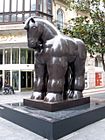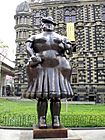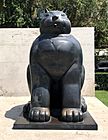Fernando Botero facts for kids
Quick facts for kids
Fernando Botero
|
|
|---|---|
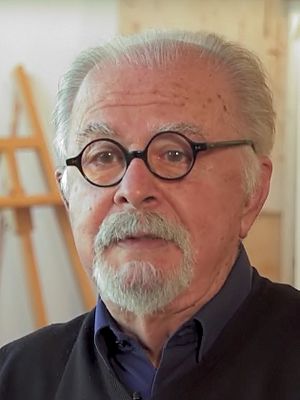
Botero in 2018
|
|
| Born |
Fernando Botero Angulo
19 April 1932 Medellín, Colombia
|
| Died | 15 September 2023 (aged 91) Monte Carlo, Monaco
|
| Known for | Painter, sculptor |
|
Notable work
|
Mona Lisa, Age Twelve (1959), Pope Leo X (after Raphael) (1964), The Presidential Family (1967), The Dancers (1987), Death of Pablo Escobar (1999), Abu Ghraib series (2005) |
| Spouse(s) | |
Fernando Botero Angulo (19 April 1932 – 15 September 2023) was a Colombian figurative artist and sculptor, born in Medellín. His signature style, also known as "Boterismo", depicts people and figures in large, exaggerated volume, which can represent political criticism or humor, depending on the piece. He was considered the most recognized and quoted artist from Latin America in his lifetime, and his art can be found in highly visible places around the world at diff, such as Park Avenue in New York City and the Champs-Élysées in Paris, at diiferent times.
Self-styled "the most Colombian of Colombian artists", Botero came to national prominence when he won the first prize at the Salón de Artistas Colombianos in 1958. He began creating sculptures after moving to Paris in 1973, achieving international recognition with exhibitions around the world by the 1990s. His art is collected by many major international museums, corporations, and private collectors. In 2012, he received the International Sculpture Center's Lifetime Achievement in Contemporary Sculpture Award.
Contents
Biography
Early life
Fernando Botero was born in Medellín to David Botero (1895–1936) and Flora Angulo (1898–1972) in 1932. His father, a salesman who traveled by horseback, died of a heart attack when Fernando was four. His mother worked as a seamstress to support the family. An uncle took a major role in his life. Although isolated from art as presented in museums and other cultural institutes, Botero was influenced by the Baroque style of the colonial churches and the city life of Medellín while growing up.
Botero received his primary education at the Ateneo Antioqueño and, thanks to a scholarship, he continued his secondary education at the Jesuit School of Bolívar. In 1944, Botero's uncle sent him to a school for matadors for two years. In 1948, Botero at the age of 16 had his first illustrations published in the Sunday supplement of El Colombiano, one of the most important newspapers in Medellín. He used the money he was paid to attend high school at the Liceo de Marinilla de Antioquia.
Career
Botero's work was first exhibited in 1948, in a group show along with other artists from the region. From 1949 to 1950, Botero worked as a set designer, before moving to Bogotá in 1951. Young Botero also worked as a newspaper illustrator to support his artistic interests and before attending San Fernando Academy. The Pérez Art Museum Miami acquired a still life picture of Botero's early days of career depicting apples, an influence of European art historical movements and 20th-century painters. His first one-man show was held at the Galería Leo Matiz in Bogotá, a few months after his arrival. In 1952, Botero travelled with a group of artists to Barcelona, where he stayed briefly before moving on to Madrid.
In Madrid, Botero studied at the Academia de San Fernando. In 1952, he traveled to Bogotá, where he had a solo exhibition at the Leo Matiz gallery.
In 1953, Botero moved to Paris, where he spent most of his time in the Louvre, studying the works there. He lived in Florence from 1953 to 1954, studying the works of Renaissance masters. Later in life, he lived most of the time in Paris, but spent one month a year in his native city of Medellín. He had more than 50 exhibitions in major cities worldwide, and his work commands selling prices in the millions of dollars. In 1958, he won the ninth edition of the Salón de Artistas Colombianos.
In 2004, Botero exhibited a series of 27 drawings and 23 paintings dealing with the violence in Colombia from 1999 through 2004. He donated the works to the National Museum of Colombia, where they were first exhibited.
In 2005, Botero gained considerable attention for his Abu Ghraib series, which was exhibited first in Europe. The series was exhibited at two United States locations in 2007, including Washington, DC. Botero said he would not sell any of the works, but would donate them to museums. In 2009, the Berkeley Art Museum acquired (as a gift from the artist) 56 paintings and drawings from the Abu Ghraib series, which can be seen online. Selections from the series have been regularly included in the museum's annual Art for Human Rights exhibitions.
In 2006, after having focused exclusively on the Abu Ghraib series for over 14 months, Botero returned to the themes of his early life such as the family and maternity. In his Une Famille Botero represented the Colombian family, a subject often painted in the 1970s and 1980s. In his Maternity, Botero repeated a composition he had already painted in 2003, being able to evoke a sensuous velvety texture that lends it a special appeal and testifies for a personal involvement of the artist. The child in the 2006 drawing has a wound in his right chest, as though the artist wished to identify him with Jesus Christ, thus giving it a religious meaning that was absent in the 2003 artwork.
In 2008, he exhibited the works of his The Circus collection, featuring 20 works in oil and watercolor. In a 2010 interview, Botero said that he was ready for other subjects: "After all this, I always return to the simplest things: still lifes."
Style
While his work includes still-lifes and landscapes, Botero concentrated on situational portraiture. His paintings and sculptures are united by their proportionally exaggerated, or "fat" figures, as he once referred to them.
Botero explained his use of these "large people", as they are often called by critics, in the following way:
"An artist is attracted to certain kinds of form without knowing why. You adopt a position intuitively; only later do you attempt to rationalize or even justify it."
Though he spent only one month a year in Colombia, he considered himself the "most Colombian artist living", due to his isolation from the international trends of the art world.
Sculpture
Between 1963 and 1964, Fernando Botero attempted to create sculptures. Due to financial constraints preventing him from working with bronze, he made his sculptures with acrylic resin and sawdust. A notable example during this time was Small Head (Bishop) in 1964, a sculpture painted with great realism. However, the material was too porous, and Botero decided to abandon this method.
Donations

Botero donated several artworks to museums in Bogotá and his hometown, Medellín. In 2000, Botero donated 123 pieces of his work and 85 pieces from his personal collection to the Museo Botero in Bogotá, including works by Chagall, Picasso, Robert Rauschenberg, and the French impressionists. He donated 119 pieces to the Museum of Antioquia, including 23 bronze sculptures for the front of the museum, whcih became known as Botero Plaza. Four more sculptures can be found nearby in Medellín's Berrio Park and San Antonio Plaza.
In response to the Colombian peace process, Botero sculpted and donated La paloma de la paz (2016) to the Government of Colombia to commemorate the signing and ratification of the agreement.
Personal life
Botero was married twice. With his first wife, Gloria Zea (1935−2019), later director of the Colombian Institute of Culture (Colcultura), he had three children: Fernando, Lina and Juan Carlos. They divorced in 1960 and Botero moved to New York, where he lived for 14 years before settling in Paris.
In 1964 Botero began living with Cecilia Zambrano. They had a son, born in 1974, who was killed in 1979 in a car accident in which Botero was also injured. Botero and Zambrano separated in 1975.
Botero's second wife was the Greek artist Sophia Vari (1940−2023), with whom he resided in Paris and Monte Carlo and also had a house in Pietrasanta, Italy. Botero's 80th birthday was commemorated with an exhibition of his works at Pietrasanta.
Death
Botero died from complications of pneumonia on 15 September 2023, at the age of 91.
Popular culture
Botero's 1964 painting Pope Leo X (after Raphael) has found a second life as a popular internet meme. It is typically seen with the caption "y tho".
Later exhibitions
- "Fund-Raiser" Exhibition with Sonia Falcone at Calvin Charles Gallery (2003), Scottsdale, Arizona
- "Botero at Ebisu" (2004), Tokyo
- "Fernando Botero" (2006), Athens
- "The Baroque World of Fernando Botero" (2007), Quebec City
- "Abu Ghraib Exhibit" (2007), University of California, Berkeley
- "Botero: Abu Ghraib" (6 November – 30 December 2007), American University Museum
- "Botero Abu Ghraib" Exposition (2008), Centro de las Artes I Monterrey, Nuevo León
- "The Baroque World of Fernando Botero" (May 2008), Delaware Art Museum, Wilmington
- "The Baroque World of Fernando Botero" (28 June – 21 September 2008), New Orleans Museum of Art
- "The Baroque World of Fernando Botero" (30 May – 16 August 2009), Colorado Springs Fine Arts Center
- "The Baroque World of Fernando Botero" (19 October – 11 January 2009), Brooks Museum of Art, Memphis, Tennessee
- "The Baroque World of Fernando Botero" (12 September 2009 – 6 December 2009), Bowers Museum, Santa Ana, California
- "Fernando Botero" (September 2009) Bandi Gallery, Seoul
- "Fernando Botero: Works On Paper, Paintings, and Sculptures" (11 February – 28 March 2010), David Benrimon Fine Art, New York, NY
- "The Baroque World of Fernando Botero" (1 May – 25 July 2010), Nevada Museum of Art, Reno, Nevada
- "Botero" (4 May – 18 July 2010), Pera Museum, Istanbul
- "Botero in LA" (15 September - 30 October 2010), Tasende Gallery, West Hollywood, California
- "The Baroque World of Fernando Botero" (21 August – 14 November 2010), Glenbow Museum, Calgary
- "The Baroque World of Fernando Botero" (10 December 2010 – 27 February 2011), Winnipeg Art Gallery, Winnipeg
- "Botero" (October 2011 – January 2012), Kunstforum, Vienna
- "Fernando Botero" (July 2015 – October 2015), Seoul Arts Center, Seoul
- "Botero in China" (November 2015 – January 2016), The National Museum of China, Beijing
- "Botero in China" (January 2016 – April 2016), China Art Museum, Shanghai
- "Botero: Celebrate Life!" (July 2016 – September 2016), Kunsthal Rotterdam
- "Botero on Lincoln Road" (November 2019 - March 2020), Nader Museum, Miami, Florida
- "Permanent Collection" (Present), NAMLA, Miami, Florida
Gallery
See also
 In Spanish: Fernando Botero para niños
In Spanish: Fernando Botero para niños
- Botero (surname) Italian surname


